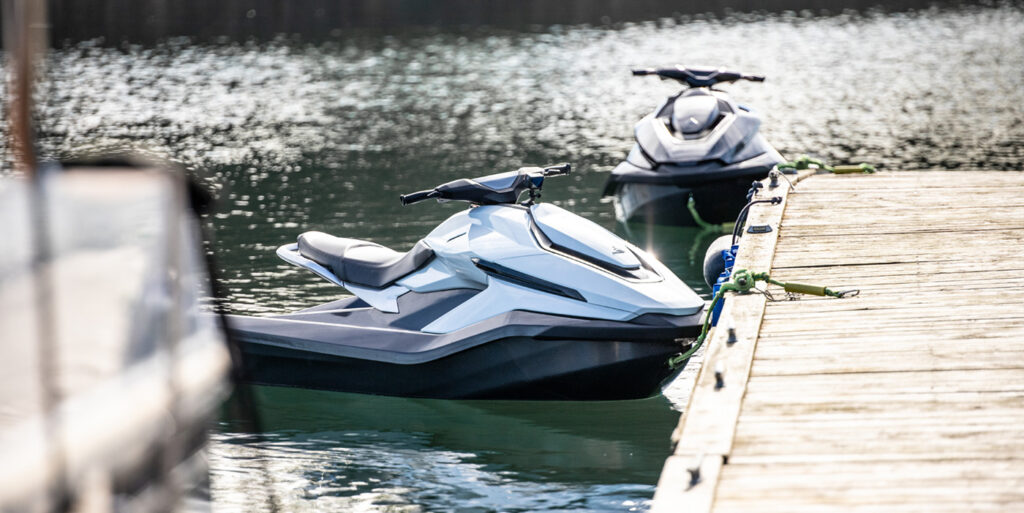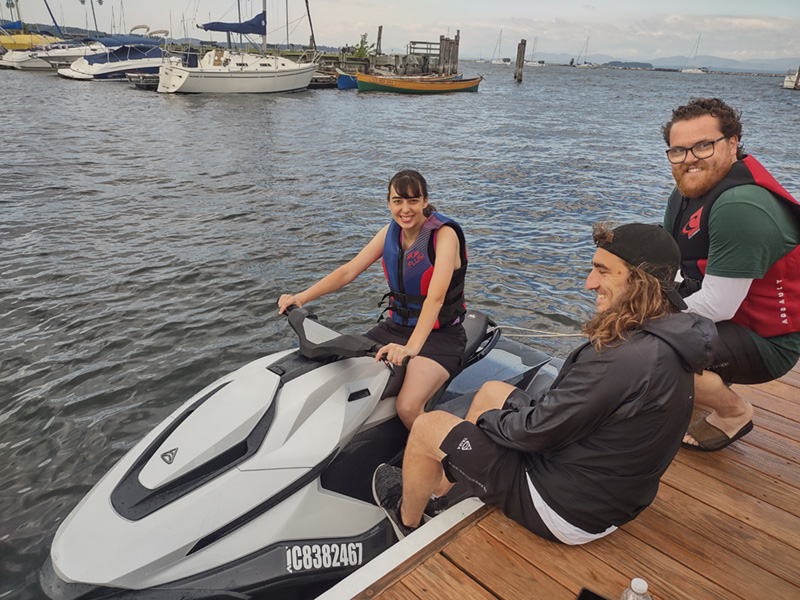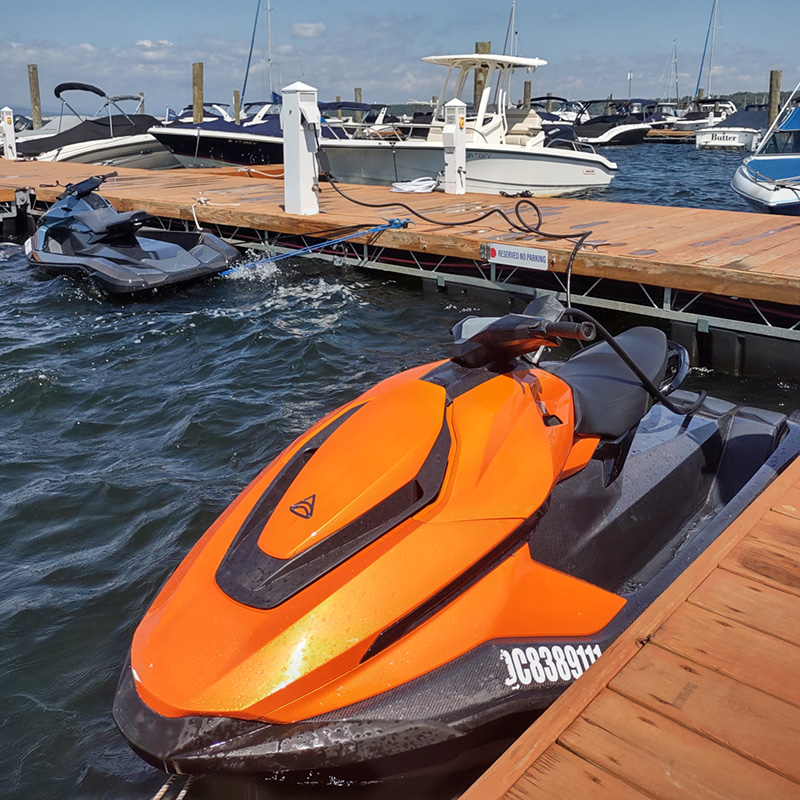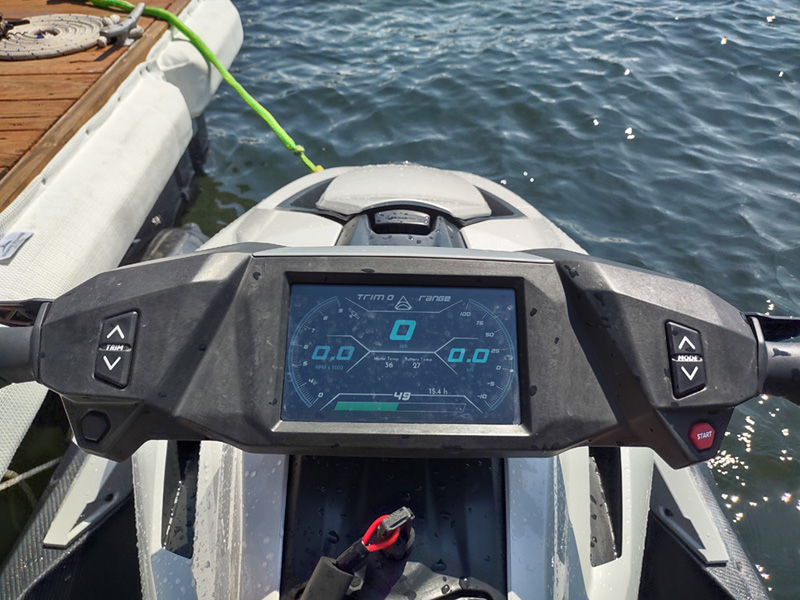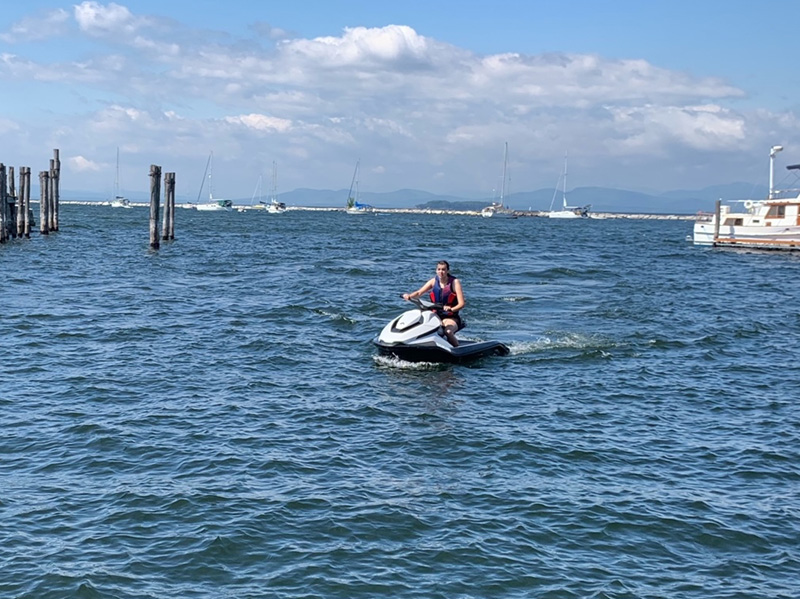Have you ever wondered what it feels like to be a dolphin — or perhaps an orca — swimming along the surface of the water and bobbing up and down through the waves? Well, a recent ride of the Taiga Orca Carbon gave me a pretty good idea.
Fresh off an hour of heavy rain, the cool waters of Lake Champlain churned along the coast of Burlington, Vermont. With the sun only just beginning to peek through the heavy clouds, few watercraft were venturing out yet onto the lake. That just meant there was more lake for me as I took out the Taiga Orca Carbon for a test ride during Taiga’s Media Ride event July 12-13.
A little choppy water proved no problem for this electric personal watercraft (PWC) – even if the driver had to stop occasionally to wipe a sheet of water off her face. With its sleek carbon-fiber hull — specially designed to cut through the water, reduce the power-to-weight ratio and help with instant acceleration — the Orca Carbon tackled the waves just like its killer namesake.
Taiga’s Electric Exploration
If you haven’t heard about Taiga Motor Co. yet, that might be because the company just started delivering its vehicles this year after being in development since 2015. Taiga CEO and Co-Founder Sam Bruneau’s vision for the business has always been to revolutionize the powersports industry with electric vehicles and outperform peers without sacrificing the environment. Now, he and the Taiga team are well on their way to seeing that mission through.
To kick off a supercharged 2022, the Canadian company delivered its first Nomad snowmobiles to the U.S.; in July. The company then released its Orca PWC — incidentally the world’s first mass-produced electric PWC available to consumers.
Regarding this groundbreaking achievement, Bruneau says, “It makes us very proud as a company. We’ve been working on this for almost seven years now. A lot of effort’s gone into making these products that people are reacting very well to, are excited about and are going to buy, so it’s a completion of a very long journey in this phase.”
But how does one go from snowmobiles to PWC, you might ask? According to Bruneau, “We started the snowmobile route because it was the most technically challenging application in powersports. Extreme cold weather, the need for very lightweight and high-powered weight ratio’s are required in those applications. We knew if we could make the technology work in a snowmobile, at that point, it would scale to all the different verticals in powersports.”
Once Taiga figured out the snowmobile, the next logical step was to complement its winter lineup with a summer one to give the company year-round profitability — hence, the Orca. In fact, Bruneau notes, both the snowmobile and PWC use the same internals, i.e. motors and batteries.
While Bruneau says that Taiga plans to apply its technology to creating other types of powersport vehicles in the future, for the present, the company will continue to focus on getting its first products out and marketing appropriately. In addition, Taiga plans to ramp up production.
“As for the year ahead, it’s about scaling production so we can fulfill customer deliveries as fast as possible. We have quite a backlog,” Bruneau confesses.
If you’ve had a chance to ride one of Taiga’s vehicles, it’s easy to see why customers are so excited about them, but for those of you who haven’t, let’s delve into the specifics of the Orca Carbon to give you an idea.
Orca Carbon Review
For a first-time PWC rider, the Orca is simple enough to operate. With the electronic lanyard key inserted, it takes only the press of the start button to power the craft. However, one of the neat power-saving features of the Orca is that, if it remains idle for 30 seconds, it automatically powers down.
A lithium-ion battery provides the juice, putting out up to 120 kilowatts and 160 horsepower. On a full charge, the Orca can get up to 28 miles of range — though of course, that’s going to depend on the power mode selected.
The Orca comes with three selectable drive modes: Range, Sport and Wild. For the purposes of the test ride, Taiga disabled the Wild mode, which it claims has twice the power of Sport mode. However, I still got to test out Range and Sport mode, and the difference was incredibly palpable – especially in rough waters. As to be expected from an electric vehicle, there is absolutely no lag on the throttle. While Range mode made for easier, slower navigation in choppy waves and would be ideal for cruising, Sport mode sent me rearing back and bouncing over them — until I would inevitably plow headlong into a larger wave and take a shower. I can only imagine what it would be like to speed on Sport or Wild mode across a calm surface.
The handlebars are fairly sensitive to turns, only requiring extra compensation for stronger currents. While the throttle is on the right handlebar, the left has a combination brake/reverse. The brake engages only if the motor is running; if clutched when at a standstill, the Orca will back up.
A 7-inch, high-definition screen on the handlebars serves as the dashboard. The center number indicates speed; RPMs are on the left, kilowatt usage on the right and battery usage on the bottom. The control system also supports over-the-air connectivity.
As for charging, the Orca Carbon can use Levels 1, 2 and 3 chargers. Charging at Level 1 takes about 14 hours but only 3.5 hours on Level 2; on Level 3, an 80% charge can be achieved in as little as 30 minutes.
As mentioned earlier, the hull of the Orca Carbon is comprised of a carbon fiber composite hydrodynamically engineered for easy handling with a leading power-to-weight ratio (the Orca only weighs 738.5 lbs). In addition, the Orca can hold two people and also boasts two storage compartments in the front and center console. It comes in several colorways, with body colors in Glacier White, Midnight Black, Ocean Blue, Glossy Red, Silver Blue, Sunset Orange and Racing Green as well as seat colors in Black, Charcoal Grey, Slate Blue and Sienna Brown.
Currently, the Orca starts at $17,490 USD, which is comparable in price to other luxury PWC models but without some of the additional features (such as extra seating or Bluetooth connectivity) found in them. All-in-all though, if you’re in the market for a torquey ride on the waves, the Orca Carbon is sure to please!

